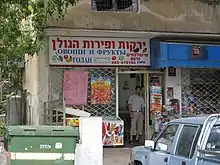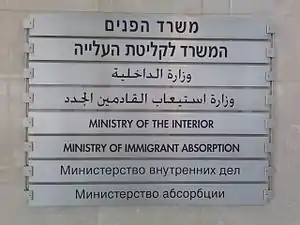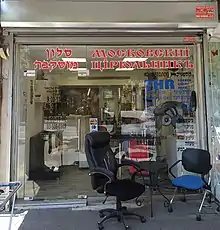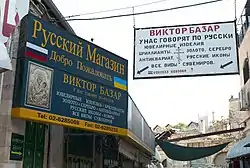

The Russian language is spoken natively by a considerable proportion of the population of Israel, mostly by immigrants who came from the former Soviet Union from 1989 onwards.[1][2][3][4] It is a major foreign language in the country, and is used in many aspects of life. Russian is the third most common native language in Israel after Modern Hebrew and Arabic. Government institutions and businesses often also provide information and services in Russian, and has effectively become semi-official in some areas with high concentration of Russian-speaking immigrants.[5][6] The Russian-speaking population of Israel is the world's third-largest population of Russian native-speakers living outside the former Soviet Union territories after Germany and the United States, and the highest as a proportion of the population.[7][8] As of 2013, 1,231,003 residents of the Post-Soviet states have immigrated to Israel since the fall of the Soviet Union.[9] As of 2017, there are up to 1.5 million Russian-speaking Israelis out of total population of 8,700,000 (17.25%).[10]
History
The first large scale immigration of Russian-speaking Soviet Jews to post-1948 Israel occurred during the 1970s, but the "great migration" did not start until the late 1980s, during the last years of the Soviet Union.
About 100,000 Jews emigrated from the Soviet Union to Israel from 1971 to 1974. Most of them were from Georgia; the Baltic states of Estonia, Latvia, and Lithuania; and areas annexed by the Red Army in 1939–1940 from Poland and Romania. Soviet authorities allowed this emigration by calling it "family reunification," to avoid the appearance that anyone was unhappy living in the Soviet state.[11] These emigrants held strongly Zionist views and took the opportunity to settle in their historic homeland.[12] Less than half of those who emigrated in the 1970s wave came from Slavic countries, i. e., Russia, Ukraine, Belarus, Poland even though about 80% of Soviet Jews lived there at the time.[13]
It was not until Perestroika that Jewish activists were given freedom to operate. The emigration that took place from 1989 to 1993 is described as a "panic migration", due to the socio-economic crisis in the Soviet states, rather than a migration of "born-again" Jews.[14] Many of them did not have any relation to Judaism or Zionism in their former place of residence.[15] Most immigrants of this period came from Russia and Ukraine, and to a lesser extent from Belarus and Central Asia.[16]
The "old immigrants" of the 1970s, who mainly came to Israel for Zionist feelings, viewed people who came during the wave of the 1980s and 1990s as people escaping a harsh economic situation who did not have much appreciation for their new homeland.[17] The last Soviet census of 1989 indicated 1,449,000 Jews living in the country, of which about 877,000 had moved to Israel by October 2000. The wave of immigration in this short period of time was the greatest influx of people to Israel since the date of its creation.[18] Immigrants from the former Soviet Union composed 50%–70% of the newcomers.[15] The number of people who came to Israel in the late 1980s and early 1990s outnumbered the number of people who came during the 1970s by four times, which made it harder for them to be integrated into the mainstream society of such a small country.[16]
Today
Integration into Israeli society


Although free Hebrew courses are offered to every immigrant, some immigrants did not take them. In 2013, about 26 percent of Russian immigrants did not speak fluent Hebrew.[19] Russians often settle close to each other, forming Russian-speaking neighborhoods with store window advertisements in Russian and banks with at least a few Russian-speaking workers.[15] Ashdod, the sixth-largest city in Israel, absorbed a particularly large number of immigrants, accepting over 100,000 Soviet Jews from 1990 to 2001.[20] The Yud-Yud Gimmel neighborhoods in southern Ashdod, where immigrants account for 75 percent of the population of 26,000, were dubbed "Israel's Russian ghetto".[21]
The process of integration into mainstream Israeli society is slow, because many Russian-speaking adults prefer to not learn Hebrew and are reluctant to give up their Russian cultural background. Language professors Elana Shohamy and Bernard Spolsky attributed this to a "strong loyalty to their ethnic language".[22]
Hayim Gordon describes the situation in his 2007 book Israel Today:
They speak only Russian to their children. They read one of the seven Russian-language newspapers that Russian-speakers have established, and they watch the private Russian TV station that has been set up in Israel and Russian stations abroad. Even after living years in Israel, hundreds of thousands of these Russian-speakers cannot carry on telephone conversation in Hebrew; many thousands of them cannot ask for directions in Hebrew. Despite these inconvenience, many Russian-speaker continue to reject the Hebrew language wherever and whenever they can.[23]
Today, Russian is in a much better position than Arabic, despite Arabic having an official auxiliary status in the country, unlike Russian.[24] The Russian-speaking adult population, which is less competitive in Hebrew than the youth, mostly tries to preserve the common Russian cultural background, teaching it to their children born in Israel.[25] However, according to Shohamy and Spolsky, second generation Israelis of Russian origin "do not receive a formal education in Russian" and, as a result, "language attrition is rapid".[6] Political scientist Ze'ev Khanin opined, "The Russian-speaking community is identifiable, but it is part of the Israeli collective. The second generation is much more influenced by its Israeli experience than its Soviet past."[26] In 2001, camp counselors in Ashdod volunteered to help youths accommodate to Israeli lifestyle, and those that participated in the program said that "they feel Israeli in every respect".[21]
Politics
As of 2022, approximately 15% of the Israeli population is Russian-speaking, and the Russian-speaking community accounts for 15 percent of Israel's eligible voters.[26][27][28] Ze'ev Khanin surmised that Russian Jews in Israel tend to be politically conservative, estimating that 50 to 60 percent supported the Likud Beiteinu coalition.[26]
Israeli journalist Lily Galili attributed this to being in part due to an unwillingness to make land concessions for the Israeli-Palestinian peace process. She explained, "They come from this huge empire to this tiny Israel and they say: 'Is that all, is that the country? And what, you want to give back the territories? Who gives up territory in the first place! And in this small country. You must be kidding!'"[28] Russian-speaking Israeli analyst Igor Khlopitsky stated that this also resulted from the Russian-speaking Israelis generally wanting quick results during times of turmoil, saying, "Those who came after Perestroika had the Soviet mentality beaten out of them by the very difficult problems of the time. And where some other Israelis see the possibilities for discussion and dialogue, they just want to solve the problems swiftly."[28]
Status and usage


Hebrew is the only official language of the State of Israel,[29] and Arabic has special status.
Russian and a number of other immigrant languages are widely used in Israel, because ethnic Jews from dozens of countries from all around the world have settled in the area. Russian is the major immigrant language of Jews living in Israel. Since 1967, millions of Russian Jews have settled in the country, and a great influx of Jews from the post-Soviet states took place in the 1990s. Today, Russian is used in cultural events, the educational system, and other public domains.[2]
By 1999, about 5 to 10 percent of all jobs in Israel were held by Russian speakers. The Ministry of Transport published booklets and manuals in Russian. It is very likely to find Russian-speaking doctors at hospitals.[30]
Education
Most Jewish immigrants from the Soviet Union were highly educated,[31] with almost 45 percent of them having some kind of higher education.[14]
Although Russian is the native language of a significant part of the country's population, it occupies a modest role in Israel's education system. Hebrew University started teaching Russian in 1962. In public schools, the first Russian-language classes were opened in the 1970s in large cities. The number of students enrolled in these programs dropped in the 1980s as immigration from the Soviet Union slowed down. In the 1990s, a Russian-language program carried out by local governments called Na'leh 16 included some 1,500 students. In 1997, about 120 schools in Israel taught Russian in one way or another.[32]
Media
Traditionally, Russian speakers read newspapers and listen to radio more often than Hebrew speakers.[25]
Nasha strana was the major Russian-newspaper in Israel during the 1970s, when it competed with Tribuna for the immigrant reader.[33] In 1989, there was only one daily in Russian, and six in 1996.[30] In the 2000s, the number of Russian-language newspapers started to decline due to the increasing influence of television and online media.[34] Israeli television provides daily translation in Hebrew, Arabic, and Russian.[35] In 2002, the Israeli Russian-speaking commercial Channel 9 was launched. It is also known as Israel Plus.[34] In November 2007, a typical digital package included 45 channels in foreign languages, with five in Russian.[35] As of 2004, there were four dailies, 11 weeklies, five monthlies, and over 50 local newspapers published in Russian in Israel, with a total circulation of about 250,000 during weekends.[33] Daily radio services in Russian are also available throughout Israel.[31]
See also
References
- ↑ Shohamy 2006, p. 70.
- 1 2 Pokorn 2010, p. 116.
- ↑ Grabe 2010, p. 155.
- ↑ Kohn 2007, p. 416.
- ↑ Isurin 2011, p. 13.
- 1 2 Spolsky & Shohamy 1999, p. 236.
- ↑ Reeves, Philip (2 January 2013). "On Multiple Fronts, Russian Jews Reshape Israel". NPR. Retrieved 23 October 2013.
- ↑ Estrin, Daniel (2 January 2013). "Back from the USSR". Times of Israel. Retrieved 23 October 2013.
- ↑ "Total Immigration to Israel by Select Country by Year".
- ↑ К визиту Нетаньяху: что Россия может получить от экономики Израиля Алексей Голубович, Forbes Russia, 09.03.2017
- ↑ Eisen 2004, p. 584.
- ↑ Allan Jones 1996, p. 27.
- ↑ Dowty 2004, p. 97.
- 1 2 Dowty 2004, p. 96.
- 1 2 3 Gordon 2007, p. 78.
- 1 2 Dowty 2004, p. 98.
- ↑ Isurin 2011, p. 14.
- ↑ Dowty 2004, p. 95.
- ↑ Druckman, Yaron (21 January 2013). "CBS: 27% of Israelis struggle with Hebrew". Yedioth Ahronoth. Retrieved 1 June 2013.
- ↑ "Data of population in the city of Ashdod" (in Hebrew). The Center for Research and Information, Knesset. April 17, 2001. Archived from the original (Word) on 27 September 2007. Retrieved September 21, 2007.
- 1 2 Rotem, Tamar (July 17, 2001). "An angel in the 'Russian ghetto'". Ha'aretz. Retrieved July 7, 2013.
- ↑ Spolsky & Shohamy 1999, p. 241.
- ↑ Gordon 2007, p. 79.
- ↑ Pokorn 2010, p. 119.
- 1 2 Rebhun & Waxman 2004, p. 106.
- 1 2 3 Sherwood, Harriet (January 18, 2013). "'Russian vote' in Israel integrates into political mainstream". The Guardian. Retrieved July 7, 2013.
- ↑ Nahshon, Gad. "The "Russian Power" in Israel". The Jewish Post. Retrieved July 7, 2013.
- 1 2 3 Kanevsky, Yevgeny (January 18, 2013). "Why Russian Israelis vote right". BBC News. Retrieved July 7, 2013.
- ↑ Lis, Jonathan; Landau, Noa (2018-07-19). "Israel Passes Controversial Jewish Nation-state Bill After Stormy Debate". Haaretz. Retrieved 2018-07-26.
- 1 2 Spolsky & Shohamy 1999, p. 237.
- 1 2 Baker & Jones 1998, p. 202.
- ↑ Spolsky & Shohamy 1999, p. 238.
- 1 2 Dowty 2004, p. 99.
- 1 2 LeVineShafir 2012, p. 317.
- 1 2 Pokorn 2010, p. 117.
Sources
- Allan Jones, Clive (1996). Soviet Jewish Aliyah, 1989-1992: Impact and Implications for Israel and the Middle East. Psychology Press. ISBN 0714646253.
- Baker, Colin; Jones, Sylvia Prys (1998). Encyclopedia of bilingualism and bilingual education. Clevedon: Multilingual Matters. ISBN 9781853593628.
- Byford, Jovan (2011). Conspiracy Theories: A Critical Introduction. Palgrave Macmillan. ISBN 978-0230272798.
- Dowty, Alan (2004). Critical issues in Israeli society. Westport, Conn.: Praeger. ISBN 9780275973209.
- Eisen, Yosef (2004). Miraculous Journey: A Complete History of the Jewish People from Creation to Present. Targum Press. ISBN 1568713231.
- Gordon, Haim (2007). Israel today. New York: Lang. ISBN 9780820478258.
- Grabe, William (2010). Reading in a second language: moving from theory to practice. Cambridge: Cambridge University Press. ISBN 9780521729741.
- Isurin, Ludmila (2011). Russian Diaspora Culture, Identity, and Language Change. Berlin: Walter de Gruyter, Inc. ISBN 9781934078457.
- Kohn, Michael (2007). Lonely Planet Israel & the Palestinian Territories (5 ed.). Footscray, Victoria: Lonely Planet. ISBN 9781864502770.
- LeVine, Mark; Shafir, Gershon (2012). Struggle and Survival in Palestine/Israel. University of California Press. ISBN 9780520953901.
- Pokorn, Nike K., Daniel Gile, Gyde Hansen (2010). Why translation studies matter. Amsterdam: John Benjamins Pub. Co. ISBN 9789027224347.
{{cite book}}: CS1 maint: multiple names: authors list (link) - Rebhun, Uzi; Waxman, Chaim I. (2004). Jews in Israel: contemporary social and cultural patterns. Hanover: Brandeis University. ISBN 9781584653271.
- Shohamy, Elana (2006). Language policy: hidden agendas and new approaches. London: Routledge. ISBN 9780415328647.
- Spolsky, Bernard; Shohamy, Elana (1999). The languages of Israel: policy, ideology, and practice. Clevedon, UK: Multilingual Matters. ISBN 9781853594519.
